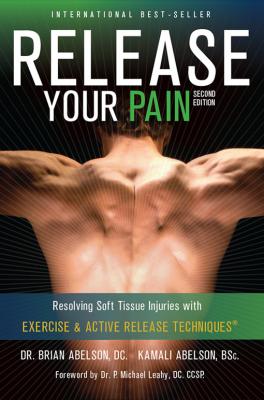ТОП просматриваемых книг сайта:
Release Your Pain: 2nd Edition - EBOOK. Dr. Brian James Abelson DC.
Читать онлайн.Название Release Your Pain: 2nd Edition - EBOOK
Год выпуска 0
isbn 9780987866219
Автор произведения Dr. Brian James Abelson DC.
Жанр Здоровье
Серия Release Your Body
Издательство Ingram
When your back is properly aligned, your ear, shoulder, and hip form a straight line. If the muscles of your back are weak, stressed, or constricted, you will lose this natural S shape, affect your good posture, and limit your ability to carry out normal tasks in comfort.
Fig 6.1: The Human Spine and its S-Curve.
Your spine performs many critical functions as it:
Contains and protects the spinal cord.
Allows a full, fluid range of motion.
Acts as an attachment site for the muscles and ligaments of the back.
The Bones of Your Spine
Your spine is divided into five major sections of vertebrae:
Cervical (neck) with 7 vertebrae.
Thoracic (mid-back) with 12 vertebrae.
Lumbar (low back) with 5 vertebra.
Sacral with 5 segments that are fused together, and are attached to the pelvis to form the sacroiliac joint.
Coccyx (tail bone) with 3 to 5 vertebral segments that are attached to the sacrum.
Spinal Vertebrae
All spinal vertebrae share many common characteristics, but also possess unique anatomical features that define their function and place in the spine.
All vertebrae have:
A vertebral body.
Two transverse processes – one at each lateral edge.
A spinous process on the posterior side.
A foramen through which the nerve roots pass.
Your intervertebral discs
The intervertebral discs (fibro-cartilaginous cushions) make up to one-quarter of the spinal column’s length, and function as the spine’s shock absorption system. They lie between, and are attached to, the vertebrae of the backbone, and form part of the front wall of the spinal canal. Intervertebral discs are designed to:
Absorb a huge amount of stress.
Act as a hinge, permitting increased range of motion and mobility in the spine.
Protect the spinal cord and its nerve roots.
The discs are made up of two primary layers:
Annulus Fibrosus – forms the outer edge of the disc and is a strong spherical structure made up of sheets of collagen fibres that are connected to the vertebral end plates (end of the vertebral bodies).
Nucleus Pulposus – forms the centre of the disc and is a gellike matter that is able to resist great compressive forces.
Since these intervertebral discs do not have a direct blood supply, they are dependant on the end-plates of the vertebral bodies to circulate essential nutrients. Any problems that cause a decrease in the normal exchange of fluids within this area can lead to a host of degenerative conditions.
Motions of the Neck and Back
Your spinal column performs four fundamental motions: flexion, extension, lateral flexion, and rotation. The majority of these movements take place in your neck (cervical spine) and in your low back (lumbar spine). The mid-back (thoracic) motion is more restricted since the vertebrae are attached to the ribs in this region.
Generally speaking, the muscles on the front of the body (anterior to the spine) are involved in the motions of flexion, lateral flexion, and rotation. The muscles on the back of the body (posterior to the spine) are involved in extension, lateral flexion, and rotation.
By observing deviations from expected normal motions, the practitioner is able to identify exactly which structures in the neck and back have been affected by a specific injury. This information also lets the practitioner determine whether the primary muscles (agonists) or oppositional muscles (antagonists) have been impacted by the injury. By combining this information with a full-body examination and an extensive palpatory examination, the practitioner is able to obtain comprehensive insight into the structures that need to be treated to resolve each spinal condition.
Thus, an injury or restriction to one structure can directly affect the function and ability of other structures far up or down the kinetic chain. By developing an understanding of these interconnections, you can quickly develop an insight into how these kinetic chain relationships work, and how a simple problem can quickly cascade into problems in multiple areas.
Soft-Tissue Layers of the Back and Neck
Your back is composed of multiple layers of tissue which can be divided into three major layers: superficial, intermediate, and deep. These multiple layers, in combination with the musculature of the abdomen, hips and shoulders, form the core of your body.
As you review the following sections of the book, we recommend that you pay particular attention to the many attachment sites for each muscle group. Many of these muscles extend from the low back, into the mid-back, and sometimes even into the neck or skull. When these structures are placed under stress (perhaps from repetitive actions) the various layers of soft tissue can become adhesed to each other. These adhesions cause biomechanical imbalances which eventually can lead to motion compensations, friction, inflammation, and a variety of physical dysfunctions.
Posterior Muscles of the Back and Neck
Intermediate Muscle Layers of the Back
Superficial Structures of the Back
Counterbalancing Structures of the Back
Muscles of the Jaw and Neck
From a kinetic chain perspective, the movements of your jaw and neck are closely linked to each other. For example, the activation of the neck and jaw muscles occurs in concert with movements of the temporomandibular joint (TMJ), cervical spine, and the

